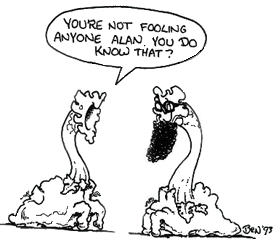Alan Robson - The Bearded Triffid
The novel was enormously popular in England and the word entered the language.
I remember as a child going for drives in the country with my parents. Whenever they saw a strange weed cowering in the hedgerow they would proclaim it to be a triffid.
A whole generation of British children grew up convinced that any plant they were unable to identify must be a triffid, and that given the least bit of encouragement it would chase after them and sting them to death...

I first read the book when I was about eight years old (I think - the exact details are a little hazy now), but I do remember that it made an enormous impression on me. It turned me into a rabid science fiction fan (a hobby I have pursued from that day to this).
A close friend, amused by the fanaticism with which I indulged my hobby, used to refer to me jokingly as the bearded triffid. The name stuck (I was quite proud of it) and I have used it ever since.
If you have any comments about the world of the Bearded Triffid, then please Contact me.
Content Last Updated: 7th December 2025